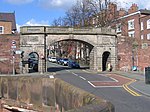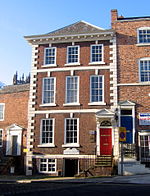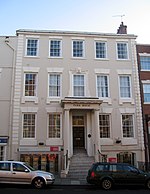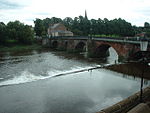Bear and Billet
1664 establishments in EnglandAll accuracy disputesGrade I listed buildings in ChesterGrade I listed pubs in CheshireHouses completed in 1664 ... and 4 more
Pubs in ChesterTimber framed buildings in CheshireTimber framed pubs in EnglandUse British English from March 2017

The Bear and Billet is a public house at 94 Lower Bridge Street, Chester, Cheshire, England. It is recorded in the National Heritage List for England as a designated Grade I listed building. The building has been described as "the finest 17th-century timber-framed town house in Chester" and "one of the last of the great timber-framed town houses in England". It stands on the west side of Lower Bridge Street to the north of the Bridgegate.
Excerpt from the Wikipedia article Bear and Billet (License: CC BY-SA 3.0, Authors, Images).Bear and Billet
Lower Bridge Street, Chester Handbridge
Geographical coordinates (GPS) Address External links Nearby Places Show on map
Geographical coordinates (GPS)
| Latitude | Longitude |
|---|---|
| N 53.1863 ° | E -2.8896 ° |
Address
Bear and Billet
Lower Bridge Street 94
CH1 1RU Chester, Handbridge
England, United Kingdom
Open on Google Maps











